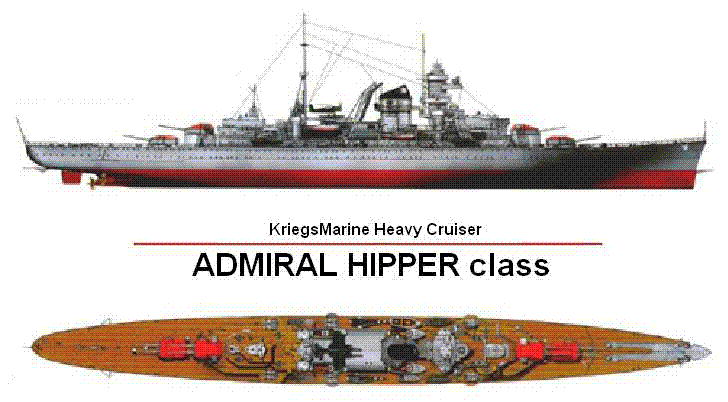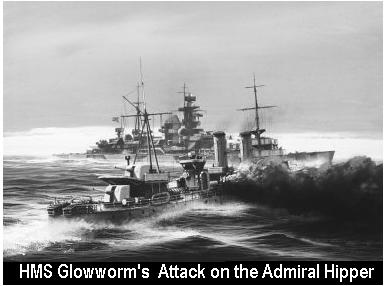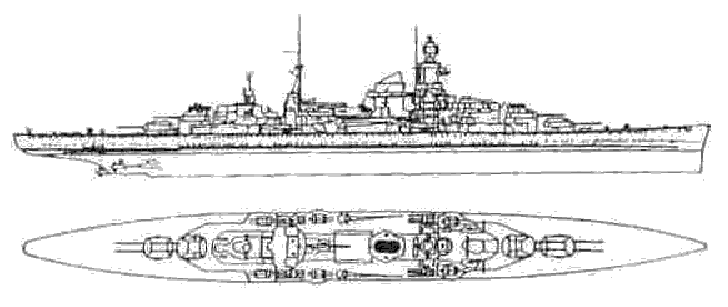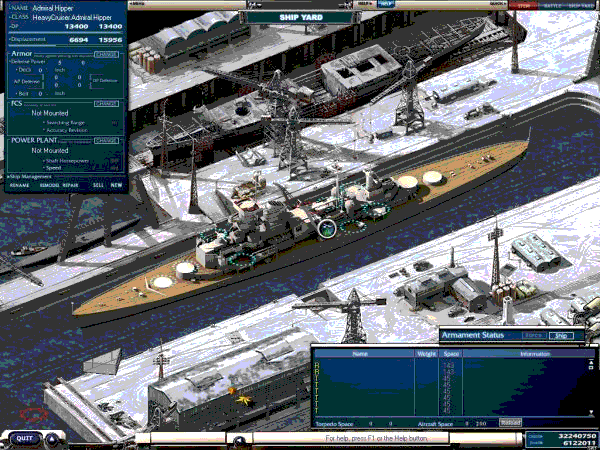The German cruiser Admiral Hipper was the lead ship of the Admiral Hipper–class heavy cruisers which served with the Kriegsmarine of Germany during World War II. 
Kreigsmarine Heavy Cruisers - Admiral Hipper Class ==========================================================================

The ship was named after Admiral Franz von Hipper, commander of the German battlecruiser squadron during the Battle of Jutland in 1916 and later commander-in-chief of the German High Seas Fleet. Admiral Hipper was the first of five ships of her class. Two others, Blücher and Prinz Eugen, were completed and served with the Kriegsmarine in the Second World War; a fourth, Lützow, was sold to the Soviet Union in 1939 before completion (and the name re-assigned to the Deutschland); and a fifth, the Seydlitz, was to be converted into an aircraft carrier but was never completed.
Heavy cruisers of the Admiral Hipper Class were products of Germany's race to rearm in the late 1930's and, for their tiime, were some of the world's most formidable and revolutionary warships.
Designed as a treaty cruiser, Germany nonetheless gave little consideration to the treaty limit of 10,000 tons displacement. The design for the Hipper-class began at 12,500 tons and increased steadily during development. To some degree, the ships were a German response to the French Algérie-class, armed with 8-inch (203 mm) guns. Several calibers were considered, but finally a battery of eight 8-inch (203 mm) guns was selected for the Hipper. This gave them comparable firepower to a British County class cruiser, despite being considerably larger. Troublesome propulsion limited cruising range to 5,000 nautical miles (9,000 km) at 15 knots (28 km/h) - far less than the original design goal of 6,500 nautical miles (12,000 km) at 17 knots (31 km/h). After construction of Hipper and Blücher, the design was slightly enlarged, although major features remained similar. Of this new design, only one was completed, Prinz Eugen.
The Admiral Hipper class ships, while comparable to heavy cruisers of other navies and considered handsome ships, suffered from some problems and were thus unsuited for some of the circumstances of World War II. Designed as part of a larger Kriegsmarine, in practice they were required to perform either as commerce raiders or support units to other naval units and ground forces, proving themselves effective in the latter role. As commerce raiders, however, they were hampered by insufficient range, lacking the cruising diesel engines of the Deutschland class cruisers (sometimes referred to as "pocket battleships"). Additionally, their power plants were unreliable. Admiral Hipper was affected by machinery breakdowns in the Atlantic and North Sea, restricting her effectiveness. Prinz Eugen suffered engine problems during Operation Rheinübung after separating from the Bismarck, causing her to terminate her anti-commerce cruise.
Three ships of the class, Hipper, Blücher and Prinz Eugen, saw service for Germany in World War II. Hipper was damaged in an attack on a convoy on New Year's Eve 1942 and remained out of service until January 1945; she was scuttled at Kiel Deutsche Werke shipyards on 2 May 1945. Blücher was sunk in Oslofjord during the German invasion of Norway. Prinz Eugen survived the war and she sank at Kwajalein Atoll on 22 December 1946 after atomic weapons tests. Lutzow was transferred to the Soviet Union in 1939 and served as the Petropavlovsk and then Tallinn in the Baltic; she was scrapped in 1950. Seydlitz was to be converted to an aircraft carrier; this project was not completed and she was scuttled at Königsberg on 10 April 1945.

Admiral Hipper took part in the German invasion of Norway (Operation Weserübung). On 8 April 1940 she encountered the British destroyer HMS Glowworm north-west of Trondheim (Norway's third largest city, roughly half way up Norway's west coast). After exchanges of fire and despite fatal damage, Glowworm turned to ram Admiral Hipper, causing damage to her before sinking.

HMS Glowworm, burning severely after receiving hits from the mighty Admiral Hipper, is depicted (above) turning to begin her heroic sacrifice off the Norwegian coast on 8th April 1940. Hugely out-gunned and already crippled, Glowworms captain, Lieutenant-Commander Roope rammed his destroyer into the side of the Admiral Hipper, inflicting a 40 metre rip in its armour belt before drifting away and exploding. 38 British sailors were rescued from the sea and Roope was awarded a posthumous VC for his bravery, the first earned by the Royal Navy in WWII.
On 9 April 1940, Admiral Hipper passed the Norwegian coastal forts in the Trondheimsfjord, being fired at ineffectively, and entered Trondheim's harbour. Troops landed from Admiral Hipper occupied the city in the early hours, flying the Nazi flag on the city's old Kristiansten fortress and other municipal buildings before most of the inhabitants were even awake.
After repairs to minor damage, Admiral Hipper operated with the battlecruisers Scharnhorst and Gneisenau off Norway to disrupt British supply routes. By October, 1940, Admiral Hipper needed serious overhauls to her machinery and returned to Kiel. Despite this work, two attempts to break out to the Atlantic were abandoned due to machinery breakdown and fires. Repairs were made at Kiel and Hamburg, delaying active service until December.
At last, Admiral Hipper broke out undetected into the Atlantic and operated as a merchant raider, based at Brest, France.
The first attack, on troop convoy WS-5A, took place in December 1940. Although one of the escorting British cruisers, HMS Berwick, was heavily damaged, the impact on the convoy was limited to damage to two merchantman. Engine problems and low fuel stores obliged Admiral Hipper to return to Brest. En route, she encountered and sank the freighter Jumna. Repairs took about a month to complete.
Admiral Hipper sailed on her second Atlantic cruise on 1 February 1941. On 12 February, she intercepted the unescorted convoy SLS-64. Seven ships out of 19 were sunk, but the convoy scattered and poor weather aided their escape. Short of 203 mm ammunition, Admiral Hipper returned to Brest on 14 February 1941.
The cruiser returned to Kiel via the Denmark Strait, arriving on 28 February 1941. Repairs were carried out and modifications made to increase fuel storage and hence her cruising range.
From March 1942, Admiral Hipper was based in Norway for operations against Arctic convoys and in preparation against an anticipated British action against Norway. On New Year's Eve 1942, she took part in the failed German attack on convoy JW-51B; where she sank the minesweeper HMS Bramble and the destroyer HMS Achates. Despite its strength, the German attack was repelled and Admiral Hipper was damaged. She returned to Wilhelmshaven, where she was decommissioned and moved to Gotenhafen.
Due to Hitler's disillusionment with the Kriegsmarine surface fleet, Admiral Hipper was not ready to re-enter service until January 1945, when she was used, partly repaired, to evacuate refugees and wounded troops from the Eastern Front.
Admiral Hipper was scuttled in dock at Kiel Deutsche Werke yards on 2 May 1945. Raised and moved to Heikendorfer Bay in 1946, she was broken up there between 1948 and 1949.

=================================================================================
NB: The above text has been collected / excerpted / edited / mangled / tangled / re-compiled / etc ... from the following online sources :
KM - Cruiser Admiral Hipper - wikipedia article #1
KM - Cruiser Admiral Hipper - wikipedia article #2
KM - Cruiser Admiral Hipper - www.battleships-cruisers.co.uk
KM - Cruiser Admiral Hipper - www.admiral-hipper-class.dk
KM - Cruiser Admiral Hipper - www.worldwartwobooks.com


